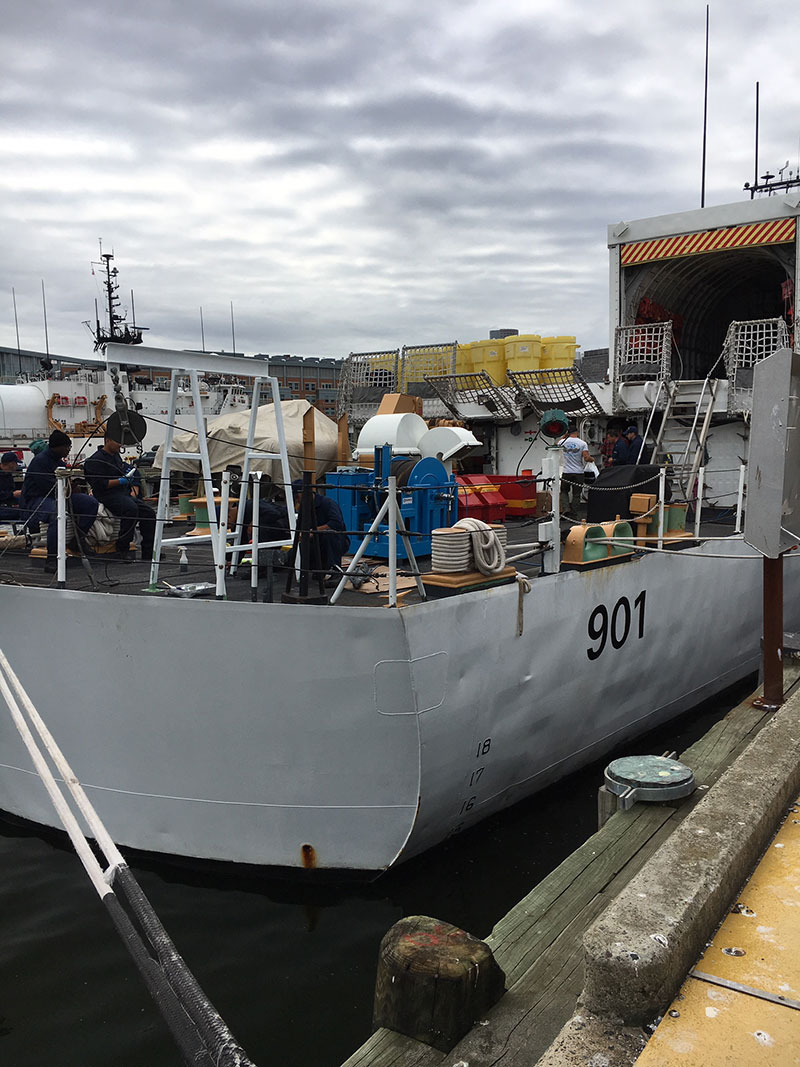
By Bradley W. Barr, Mission Coordinator, NOAA Office of National Marine Sanctuaries, Maritime Heritage Program
September 12, 2019

Newly installed equipment on the fantail of the U.S. Coast Guard Cutter Bear. Image courtesy of the Search for the U.S. Revenue Cutter Bear. Download image (jpg, 1.7 Mb).
After nearly two decades of planning, the “Search for the Bear” is finally happening! The U.S. Coast Guard Cutter Bear is arriving at the pier in Boston this afternoon and all the survey equipment has been shipped and received, awaiting loading onto the ship. The 4,100-pound winch needed to deploy and recover the side scan sonar array has arrived and will be lifted onto the deck of the Bear very soon. The terrific work by the officers and crew of the Bear to adapt the Cutter to become a “research vessel” capable of supporting this mission has been completed in anticipation of the installation of the winch.
The mission team will arrive tomorrow to begin to install the survey systems and conduct critical dockside testing before we embark, to be certain everything is operating effectively...and then settle into their quarters on the Bear for a good night’s rest before we head to sea. Everything has gone unexpectedly smoothly, which is surprising given the many “moving parts” of mobilization usually encountered with survey missions like this. Once at sea, we are on our own, so effective and thorough planning for all of the unexpected challenges that could arise is absolutely critical.
If it “takes a village to raise a child”, it “takes a city” to conduct a seabed mapping mission. While there are way too many people to thank individually for their extra efforts and support that got us to this point, we are deeply grateful to the scores of highly effective professionals that have made indispensable contributions. Our mission partners from the U.S. Coast Guard (USCG), both the excellent officers and crew of the Bear and the many good folks we have met along the way at Base Boston that facilitated the mobilization are always an inspiration, everyone possessing the “can-do” attitude that makes things happen. Colleagues at the Stellwagen Bank National Marine Sanctuary, who worked with us to facilitate the shipping of equipment (including helping to move very heavy equipment cases), also stood tall with their support. The financial support provided by the NOAA Office of Exploration and Research (OER), and the excellent work of the OER web team in getting this web presence up and running is very much appreciated. The mission would not have been possible without their shared enthusiasm, over the years, for this “Bear hunt.”
Not to be forgotten are the many, many individuals that contributed both their knowledge, expertise, and sustained support in planning this mission, particularly the principal partners from the USCG Historian’s Office, the USCG Auxiliary, and NOAA/OER. We also acknowledge the support of the NOAA Office of National Marine Sanctuaries for their support in giving us the latitude to devote our time and efforts to this important joint mission with the Coast Guard and NOAA OER.
Last but certainly not least is the mission team, who have willingly offered their valuable time to go to sea with us; contributed the extensive background information provide on the website; and endured my obsessive communications, lengthy emails, and conference calls to coordinate their involvement. As we contemplate leaving the dock and heading out to sea, we take this “city” of support with us, grateful for their shared vision of finding the final resting place of this Arctic icon, the Revenue Cutter Bear.